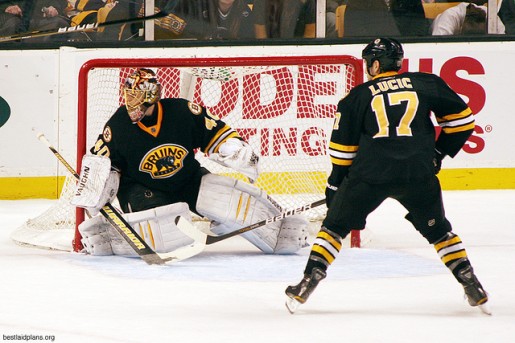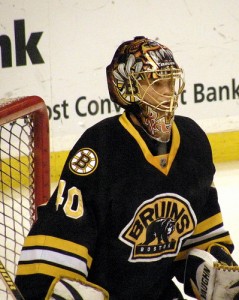
In recent days, there have been a number of rumblings around teams trying to acquire a goaltender. Boston hasn’t been aloof from this as TSN’s Bob McKenzie and CSNNE’s Joe Haggerty have confirmed that the Bruins have received inquiries about the availability of their young, talented backup, Tuukka Rask – notably from their opponent Thursday, the Columbus Blue Jackets.

Some within the hockey community argued that Rask’s value as a goalie was pretty minimal. They looked at some recent deals for young netminders (Jaroslav Halak, Semyon Varlamov, Kari Lehtonen) and argued that the best the Bruins could receive in return was some prospects or picks – hardly worth it for your backstop of the future. Others speculated that Rask could be the centerpiece in a deal for Rick Nash.
Now, aside from getting completely rejected in those talks, the Blue Jackets have managed to rile up a discussion that has ramifications around the League: How much is a goaltender really worth, and should teams pay top dollar for top talent in the position?
The Uneven Value of ‘Tenders
Right now there are 25 goaltenders with a cap hit above $2 million in the NHL. Six teams have starting goalies who make that or less in a season. Not one of Toronto, Washington, Phoenix, Los Angeles, Florida and Winnipeg has a goalie on their books making more. With the successes some of these squads have achieved this year and teams without a upper-echelon goalie have enjoyed in recent seasons (Detroit in 2008,2009; Chicago in 2010; Philadelphia in 2010), many saw as an indictment of the traditional belief that a top goalie was necessary for success.
Of course in recent months, some have flipped back to the belief that goaltending is essential with the Bruins Stanley Cup victory backstopped by Tim Thomas, the postseason failures of teams with ‘goaltending by committee’ and the massive contracts and deals for valuable netminders: Pekka Rinne, Ilya Bryzgalov and Semyon Varlamov.
The past thirty years have seen some dynamic changes in how the position is taught, equipped and played. From the burgeoning size of a netminders’ pads to the numerous changes in the mechanics of goaltending (not the least of which was the near-universal adoption of the butterfly style), goalies today would be almost unrecognizable to players and fans even as recently as the 1980s.
These changes (coupled with others not exclusive to goaltending) have significantly adjusted the statistical definitions of quality goaltending. In 1990-91, there were exactly five goaltenders with 800 minutes played who registered a .900 save percentage or higher. The median of the 44 qualifiers was .889 Sv%. Last season there were 45 goalies with a .900 Sv% or above with 800 minutes played and the median sat at a lofty .914 Sv%. Only one starting ‘tender with 50+ games (Brian Elliott) had a save percentage under .900 (.893).
Goalie Valuation Arguments – Stats and More Stats
While many have posited that goalie is the most important position in hockey (and sometimes all of team sports…) does this stand up to scrutiny? David J. Berri and Martin B. Schmidt, authors of Stumbling on Wins, argue against that: “…there is simply little difference in the performance of most NHL goalies…” and as a result, they are overpaid.
It’s certainly become a popular opinion around the NHL. With the sterling successes in recent years of teams without top-flight netminders (Detroit in 2008 and Chicago in 2010 stand out) there was a burgeoning feeling that as long as your goalie wasn’t an active detriment to your squad, spending your money elsewhere was ideal.
The authors’ of Stumbling on Wins numbers have been called into question (there’s a great article disputing Berri and Schmidt’s analysis over at Phil Birnbaum’s Sabermetric Research Blog with a much more sophisticated brand of statistical investigation than I can provide) but there’s some value to the argument.
While it’s statistically possible for a goalie to stop 100% of the shots he faces in a season, for all practical applications that day is extremely unlikely. So, as goalies creep closer and closer to the ‘upper limit’ of their potential for puckstopping, it’s bound to be harder and harder to differentiate between the ‘good’ and ‘great’ or even the ‘great’ and ‘average’.
However, as it stands now there’s some considerable debate in the community about how many goals/wins an elite goaltender is worth versus the Antti Niemis of the world. Puck Prospectus’ Tom Awad’s Goals Versus Threshold metric is an attempt at normalizing value across the League. Last season, the top six players in GVT were all goaltenders, highlighted by Tim Thomas’ 40.0, ahead of the nearest skater (Daniel Sedin) by a whopping 13.8 goals. Versus an average ‘tender like Niemi (who still had a plus season in ’10-’11), Thomas was worth almost 23 goals more. The other top-six tenders according to this metric (Pekka Rinne, Henrik Lundqvist, Carey Price, Roberto Luongo, Cam Ward) exceed the middle tier of starters by equally impressive numbers.
The bunching of top goalies near the top of the GVT rankings isn’t a one-year thing, either. In 2009-10, while there wasn’t a six-pack of goalies above the skater riff-raff, there were two (Ryan Miller and Evgeni Nabokov) followed by a pair of elite forwards (Alex Ovechkin and Sidney Crosby) and then a five-spot of netminders to follow. Seven of the top nine GVT’s in ’09-’10 patrolled the crease. Undoubtedly, GVT has its flaws (many of these resulting from its reliance on the NHL’s extremely limited statistical base) but it’s certainly at or near the top of available analytics for global player studies.
If GVT is right and goalies can make enormous contributions to a team’s success or failure, why were so many hockey pundits selling goalies’ importance short?
Perception vs. Reality and the Under-Valuation of Netminders
Part of the problem was due to the importance of postseason hockey and sample-size. The big talking heads of the world put an inordinate amount of weight on playoff results. When elite goaltenders seem to falter in seven-game series, people point at the position and suggest that it’s overrated. When average or below goaltenders find themselves on successful runs (think Kirk McLean, who saved over 92% of the shots he faced during Vancouver’s improbable run to the 1994 Stanley Cup Final, and yet had a career save percentage of .887) the same ideas are circulated.
Because of the extremely small sample-size, luck plays a much bigger role in postseason numbers. To the detriment of many players forever described as ‘chokers’ or just not ‘clutch’, people take the small statistical pool of the playoffs and apply it as gospel.

Another reason some believe that goalies are indistinguishable (statistically) is that drafting them is basically a crapshoot. In Alvin Chang’s ESPN NHL Draft Blog, he discusses how difficult it is to select goalies who’ll be successes down the road. If forwards are frequently correctly pegged and defenseman are challenging – goalies are a whole other level of mystifying – top-picked goalies don’t pan out at the rate you’d expect and goalies drafted well into the second day like Rinne (seventh round) and Thomas (ninth round) can end up being better .
Additionally, some try to make the argument that the major goalie statistic at our disposal (Save Percentage) seems to implicate that goalies are inconsistent, with much of their rise and fall due to luck or external factors such as team defense. For example, a goaltender with a save percentage of .930 compared to a league average of .910 in one season would be expected to regress significantly toward that mean the next season rather than continue at an elite rate.
There is more than a little debate on how significant the dichotomy between talent and luck is in goaltending, but some would suggest that a regression to .915 for the previously-mentioned hypothetical goalie in question while others would argue for a predicted .920 Sv% following the .930 season. Same difference, right? Wrong. The top six goalies in GVT faced an average total of just under two thousand shots in their 2010-11 seasons (1993) that difference (.920 vs. .915 predicted Sv%) means ten more goals allowed, definitely significant when you’re talking about one player, adding ten goals to the 120 or so he’s already allowed.
This brings us to another issue on why differences between goalies are underestimated. Individuals looking to examine these players take a once-over on the most telling NHL-provided goalie stat (Save Percentage) and are underwhelmed by the .003 difference between their goalie and the goalie next door for a half million cheaper. If they’re starters, this translates to a difference of six or so goals over the course of a season, not a gigantic total but significant nonetheless.
Another reason we find goalies undervalued is that all too often, goalies for solid defensive teams are undervalued because of the system they play behind. Consider how, in recent years, pundits and analysts have tried to diminish the accomplishments of netminders like Thomas, Rinne and others because they played in places that stressed intelligent and defensively responsible hockey far from the run ‘n gun styles employed by some franchises. Fortunately for some, there’s potential redemption in a newly-developed stat: Defense Independent Goalie Rating (DIGR).
DIGR, created by St. Lawrence University’s Michael Schuckers, takes goalies’ defenses out of the equation by mapping a goalies’ shot faced by situation, opponent, type and range. The resulting data gives an ‘adjusted’ save percentage value, DIGR, which can be compared to goaltenders from around the League. In his 2010-11 analysis, Thomas retains his top spot among NHL goalies but drops from a .939 Sv% to a .931 DIGR because of the relative ease of the shots he faced. Pekka Rinne drops significantly and falls in the rankings – from second to twelfth because of shot difficulty.
—
What does this mean for Tuukka? Well, for starters, his DIGR and save percentages are among the League’s best since his rookie season: He trails only Thomas in GAA and Sv% since he came up in the League and is one of a few to finish in the top-20 in DIGR each of the past two campaigns. He arguably has more value than any of the three previously-mentioned, dealt goalies (Halak, Varlamov, Lehtonen). In the current marketplace he might not have the value needed to make a deal for a game-changing skater, but it’s wrong to argue that mediocre prospects or picks would be all that he’d return.
Unfortunately for goaltenders, some analysts will continue to undervalue their performances because there are several ‘overpriced’ goaltenders under contract with no way of living up to those deals, like Rick DiPietro and Cristobal Huet (Pekka Rinne?), making many skeptical of handing money over for elite goaltenders as a whole. Part of the problem is the fact that some weigh postseason production excessively. Part of the problem is even with things like DIGR, we haven’t found a mechanic to completely analyze goalie performance. A part of the problem is some equate goaltending performance (incorrectly) to three parts luck, one part defense and a quarter measure of talent.
Until we agree on the terms and scope of acceptable analysis, Tuukka Rask and goalies in general are going to have to deal with being devalued.